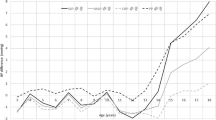Abstract
Two equations have been developed that describe the interrelationship of the clinically measurable variables of the human systemic arterial system. An approximation method is given for their simultaneous solution for systolic and diastolic pressures in terms of heart rate, cardiac output, total peripheral resistance, and aortic distensibility. In this way, blood pressures were calculated for various clinically important and didactically useful situations. The effects on systolic and diastolic pressures due to changing either cardiac output or peripheral resistance or heart rate or aortic distensibility alone are shown. The effects on pulse pressure of varying cardiac output and peripheral resistance while holding mean arterial pressure constant are demonstrated. Compensatory mechanisms in hypertension and exercise are explored.
Similar content being viewed by others
Literature
Alexander, R. S. 1954. “The Influence of Constrictor Drugs on the Distensibility of the Splanchnic Venous System, Analyzed on the Basis of an Aortic Model.”Circ. Res.,2, 140–148.
Brandfonbrener, M., M. Landowne, and N. W. Shock. 1955. “Changes in Cardiac Output with Age.”Circulation,12, 557–566.
Cope, F. W. 1960. “An Elastic Reservoir Theory of the Human Arterial System Using Modern Data on Aortic Elasticity.”Bull. Math. Biophys.,22, 19–40.
— 1961. “A Method for the Computation of Aortic Distensibility in the Living Human Patient and Its Use for the Determination of the Aortic Effects of Aging, Drugs and Exercise.”Bull. Math. Biophys.,23, 337–353.
Goldenberg, M., K. L. Pines, E. deF. Baldwin, D. G. Greene, and C. E. Roh. 1948. “The Hemodynamic Response of Man to Nor-epinephrine and its Relation to the Problem of Hypertension.”Am. J. Med.,5, 792–806.
Grob, D., W. R. Scarborough, A. A. Kattus, and H. G. Langford. 1953. “Further Observations on the Effects of Autonomic Blocking Agents in Patients with Hypertension.”Circulation,8, 352–369.
Karpovich, P. V. 1953.Physiology of Muscular Activity. 4th Edition. Philadelphia: Saunders Co.
Landowne, M., M. Brandfonbrener, and N. W. Shock. 1955. “The Relation of Age to Certain Measures of Performance of the Heart and the Circulation.”Circulation,12, 567–576.
Remington, J. W., C. B. Noback, W. F. Hamilton, and J. J. Gold. 1948. “Volume Elasticity Characteristics of the Human Aorta and the Prediction of the Stroke Volume from the Pressure Pulse.”Am. J. Physiol.,153, 298–308.
Riley, R. L., A. Himmelstein, H. L. Motley, H. M. Weiner, and A. Cournand. 1948. “Studies of the Pulmonary Circulation at Rest and During Exercise in Normal Individuals and in Patients with Chronic Pulmonary Disease.”Am. J. Physiol.,152, 372–381.
Scarborough, J. B. 1930.Numerical Mathematical Analysis. Baltimore: Johns Hopkins Press, pp. 187–9.
Widder, D. V. 1947.Advanced Calculus. New York: Prentice Hall, pp. 35–6.
Wiggers, C. J. 1950.Physiology of Shock. New York: The Commonwealth Fund.
Wiggers, C. J., and R. Wegria. 1938. “Active Changes in Size and Distensibility of the Aorta During Acute Hypertension.”Am. J. Physiol.,124, 603.
Author information
Authors and Affiliations
Additional information
Opinions and conclusions contained in this report are those of the author. They are not to be construed as necessarily reflecting the views or the endorsement of the Navy Department.
Rights and permissions
About this article
Cite this article
Cope, F.W. A method for calculation of human systolic and diastolic blood pressures using an elastic reservoir theory of the systemic arterial system, and some clinical and physiological applications. Bulletin of Mathematical Biophysics 24, 137–157 (1962). https://doi.org/10.1007/BF02477423
Received:
Issue Date:
DOI: https://doi.org/10.1007/BF02477423




